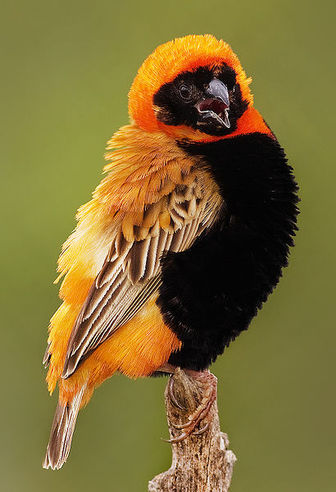Red bishop
It is 10-11 centimetres long and has a thick conical bill. Breeding males are brightly-coloured with red and black plumage. The forehead, face and throat are black and the rest of the head is red. The upperparts are red apart from the brown wings and tail. The upper breast and under tail-coverts are red while the lower breast and belly are black. The non-breeding male and female have streaky brown plumage, paler below. Females are smaller than the males.

Original source: Own work
Author: Noodle snacks (http://www.noodlesnacks.com/), cropped by Papa Lima Whiskey
The Red bishop is classified as Least Concern. Does not qualify for a more at risk category. Widespread and abundant taxa are included in this category.
The Northern Red Bishop or Orange Bishop (Euplectes franciscanus) is a resident breeding bird species in Africa south of the Sahara Desert and north of the Equator. It has been introduced to Puerto Rico, Martinique and Guadeloupe in the West Indies. It was formerly regarded as a subspecies of the Southern Red Bishop (Euplectes orix) of the southern half of Africa. The two are now usually classified as separate species. More
The Southern Red Bishop or Red Bishop (Euplectes orix) is a small passerine bird belonging to the bishop and widowbird genus Euplectes in the weaver family Ploceidae. It is common in wetlands and grassland in Africa south of the Equator. North of the Equator, it is replaced by the Northern Red Bishop or Orange Bishop (E. franciscanus) which was formerly regarded as a subspecies of this species. More
red bishop (Euplectes orix): is there evidence for the good-genes hypothesis?" Behaviour 139:777-800. Friedl, T.W.P. (2004a). "Breeding behaviour of the Red Bishop (Euplectes orix): a synthesis and new observations." Die Vogelwarte 42:178-190. Friedl, T.W.P. (2004b). "Extrapair fertilizations in red bishops (Euplectes orix): do females follow conditional extrapair strategies?" The Auk 122:57-70. Friedl, T.W.P. (2004c). More
Red Bishops nest preferentially in reeds growing in shallow water (Skead, 1956). Each male's territory cover's roughly 90 sq. ft. (Skead, 1956) and the quality of territories appears to be very similar across the board (Friedl & Klump, 1999). The colony is usually highly concentrated in a small patch of reeds and territories are used for mating and nesting while food is found elsewhere (Skead, 1956; Friedl & Klump, 1999). Males occasionally leave their territories unguarded to forage or drink (Skead, 1956). More
Red bishops have become established... Other The following is a selection of items (artistic styles or groups, constructions, events, fictional characters, organizations, publications) associated with "red bishop" * bishop (bird) Expand Your Research: Try searching magazines and ebooks for "red bishop". No results found. More
The Red Bishop is one of three species commonly called Orange Weaver in the pet trade. More
Accueil du site > Actualités > Dans les revues > The red bishop in ParaguayVersion imprimable de cet article Version imprimable | Enregistrer au format PDF Version PDF | envoyer l'article par courriel title= envoyer par courriel The red bishop in Paraguay = publié : le 17 mars 2008 « The Red Bishop in Paraguay » ( « L’évêque rouge du Paraguay ») constitue une brillante contribution pour comprendre la situation politique de ce pays. More
thousands of years of high energy mega-shows, Red Bishop had failed to land the all important record contract. Some speculate that it was the band's support of Jesus Christ when he chased the money changers out of the temples of Jerusalem. Whatever the reason, the band finally took a hiatus and settled in the Lehigh Valley shortly before the pyramids in Quakertown were erected. More
red bishops (slideshow images 11 - 17) near Nanja dam in May 2006 following good rains with lots of standing water in the area. They were feeding on seeds and flying insects. More
Breeding males of the Northern Red Bishop have a red throat, black extending further back on the crown and long tail-coverts which almost cover the tail. The females and non-breeding males are almost identical to those of the Southern Red Bishop. Distribution and habitat It occurs from South Africa north to Angola, southern and eastern parts of the Democratic Republic of Congo, southern Uganda and south-west Kenya. It is largely absent from the Namib Desert and Kalahari. More

Original source: Drew Avery
Author: Drew Avery
Permission: Some rights reserved
Family : Ploceidae
Genus : Euplectes
Species : orix
Authority : (Linnaeus, 1758)

